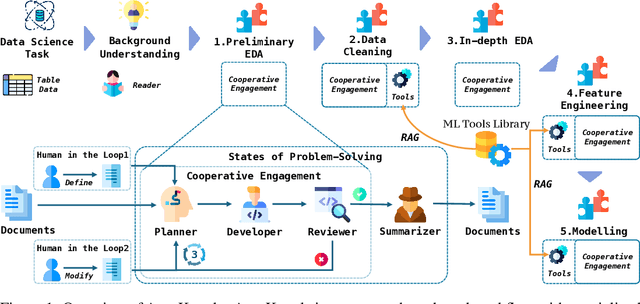David Ma
AutoKaggle: A Multi-Agent Framework for Autonomous Data Science Competitions
Oct 29, 2024



Abstract:Data science tasks involving tabular data present complex challenges that require sophisticated problem-solving approaches. We propose AutoKaggle, a powerful and user-centric framework that assists data scientists in completing daily data pipelines through a collaborative multi-agent system. AutoKaggle implements an iterative development process that combines code execution, debugging, and comprehensive unit testing to ensure code correctness and logic consistency. The framework offers highly customizable workflows, allowing users to intervene at each phase, thus integrating automated intelligence with human expertise. Our universal data science toolkit, comprising validated functions for data cleaning, feature engineering, and modeling, forms the foundation of this solution, enhancing productivity by streamlining common tasks. We selected 8 Kaggle competitions to simulate data processing workflows in real-world application scenarios. Evaluation results demonstrate that AutoKaggle achieves a validation submission rate of 0.85 and a comprehensive score of 0.82 in typical data science pipelines, fully proving its effectiveness and practicality in handling complex data science tasks.
Balancing Effect of Training Dataset Distribution of Multiple Styles for Multi-Style Text Transfer
May 24, 2023Abstract:Text style transfer is an exciting task within the field of natural language generation that is often plagued by the need for high-quality paired datasets. Furthermore, training a model for multi-attribute text style transfer requires datasets with sufficient support across all combinations of the considered stylistic attributes, adding to the challenges of training a style transfer model. This paper explores the impact of training data input diversity on the quality of the generated text from the multi-style transfer model. We construct a pseudo-parallel dataset by devising heuristics to adjust the style distribution in the training samples. We balance our training dataset using marginal and joint distributions to train our style transfer models. We observe that a balanced dataset produces more effective control effects over multiple styles than an imbalanced or skewed one. Through quantitative analysis, we explore the impact of multiple style distributions in training data on style-transferred output. These findings will better inform the design of style-transfer datasets.
 Add to Chrome
Add to Chrome Add to Firefox
Add to Firefox Add to Edge
Add to Edge